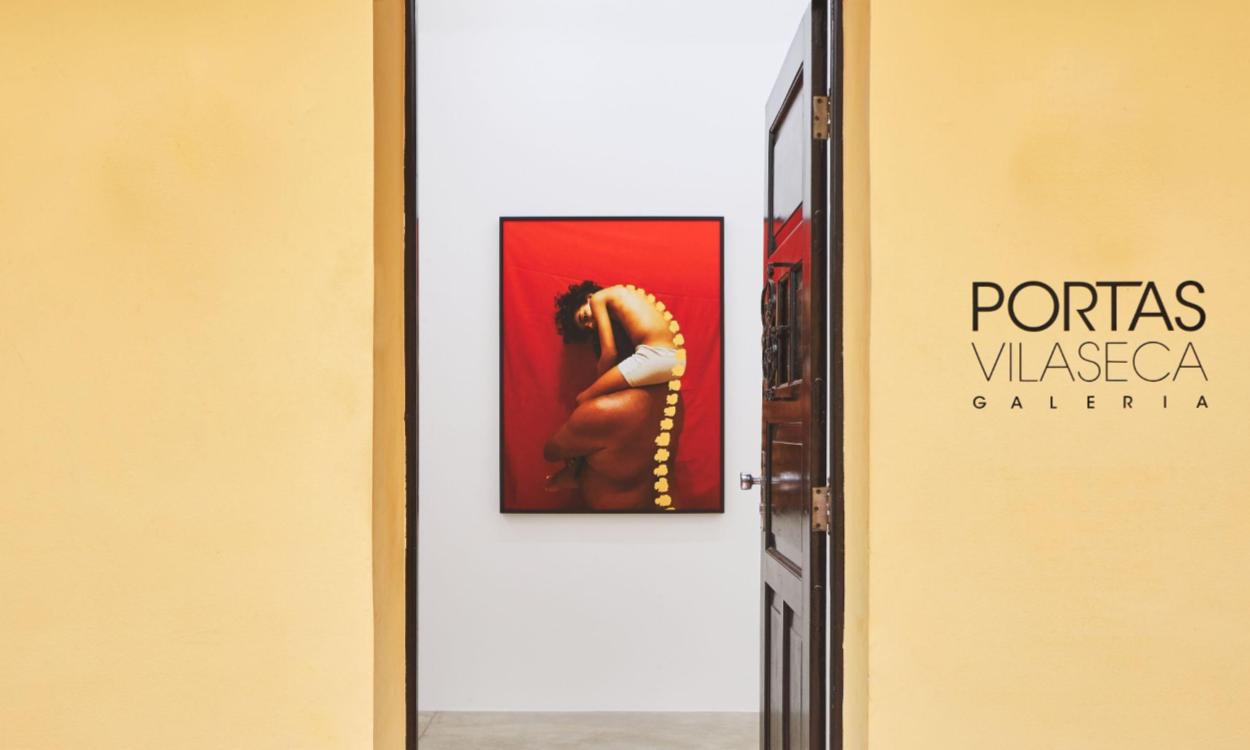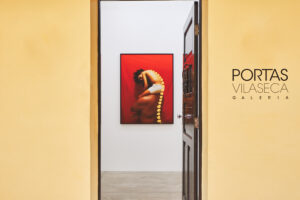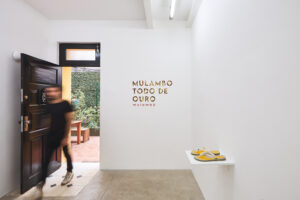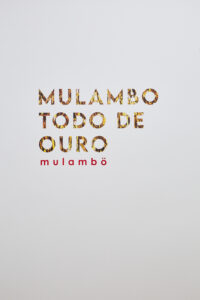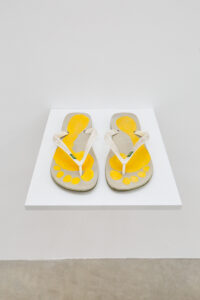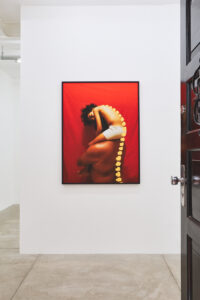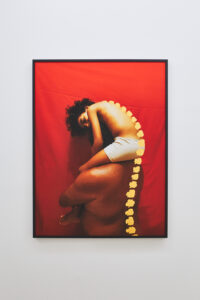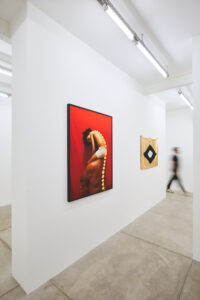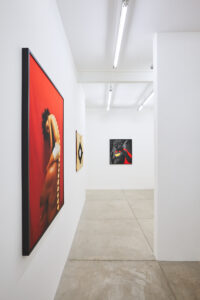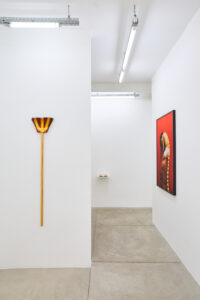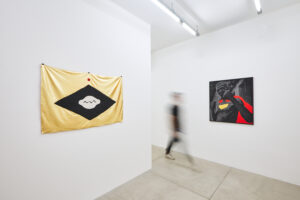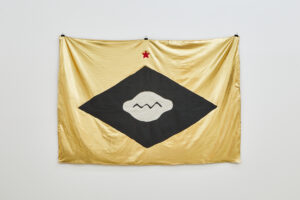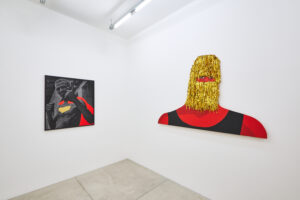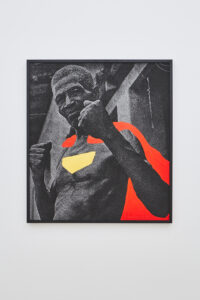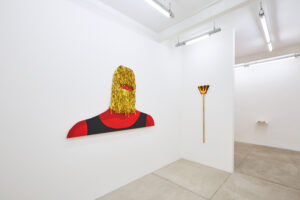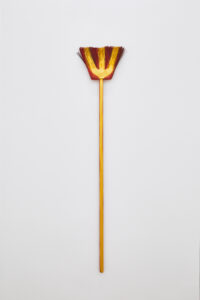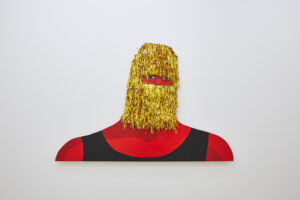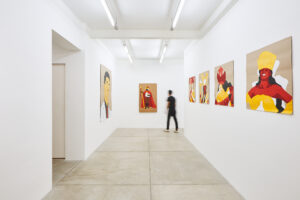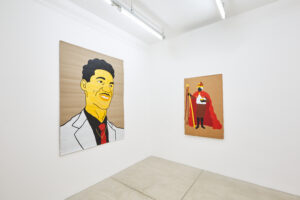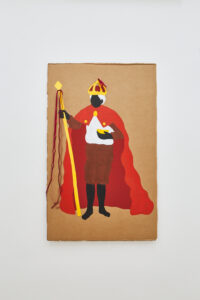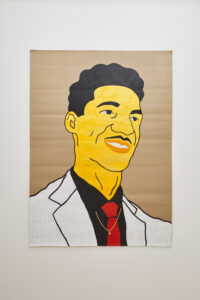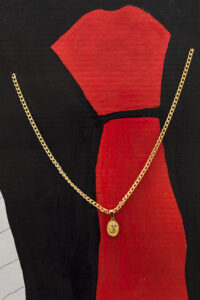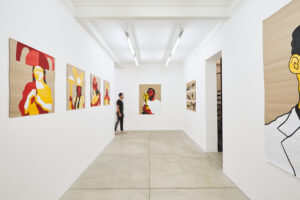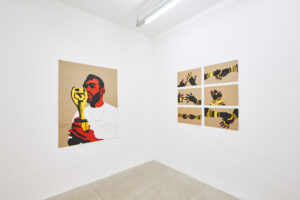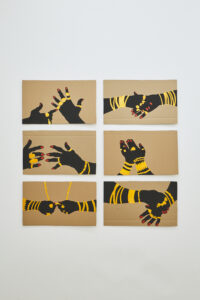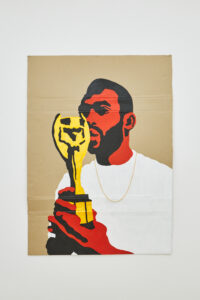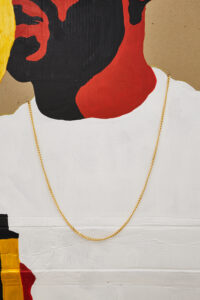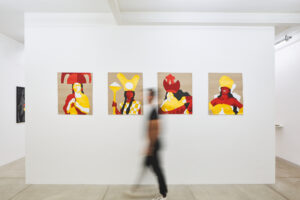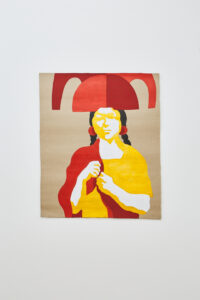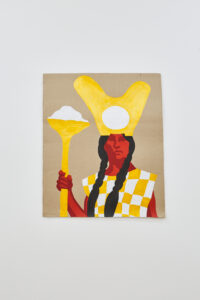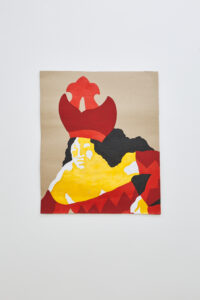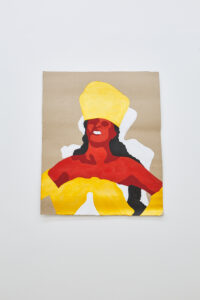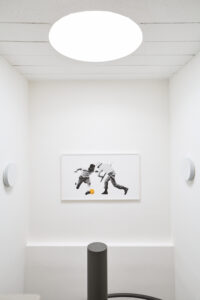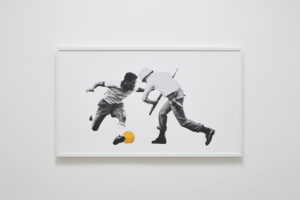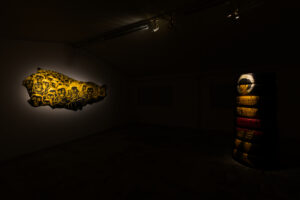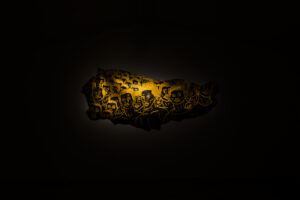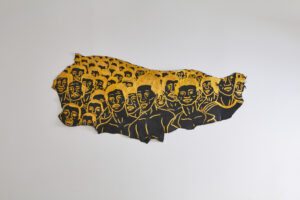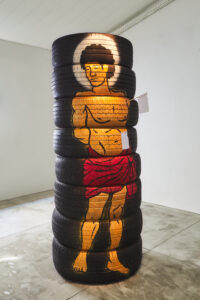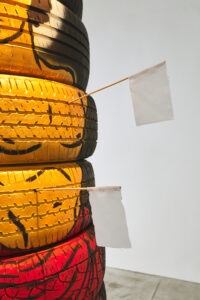“Mulambö all in gold” inaugurates Portas Vilaseca Galeria annual exhibition calendar.
Mulambö’s first solo show at Portas Vilaseca Galeria brings together unpublished works by the artist, who also signs the curatorship. The critical essay has been written by curator and researcher Raphael Fonseca.
The artist pursues some of his central interests: the creation of images through painting and digital manipulation, in addition to the appropriation of utilitarian objects. Playing with the fact that this is his first exhibition in a commercial gallery, Mulambö presents himself “painted in gold” and also referring to the golden / yellow color used constantly in his research. Through paintings, sculptures and interventions in photographs, his works dialogue with certain icons of the culture of Rio de Janeiro (also known as “Carioca culture”), such as Saint Sebastian (the patron saint of the city), Carnival, football and samba. When playing with these icons, Mulambö also plays with the multiple stories that make up not only the city, but Brazil as a whole. Here is an essential subject for his research: time and its ability to enable the public to use different imagination exercises.
“Mulambö all in gold” is an exhibition about values, about weights and powers. Understanding gold beyond the precious stone meaning – but also as a symbol of wealth and strength, and at the same time, of exploration and dispute. A gold that is beautiful, but that also reflects a past of violence.
“Mulambö all in gold” is an exhibition about all the brilliance and violence that gold carries, and also about all the brilliance and violence that we carry.
Respecting the latest municipal instructions and all WHO recommendations, the gallery is not open to the public at the moment and should concentrate all activities related to this exhibition virtually. We hope to get back to our visits by appointment in the space very soon!
Click here to download the digital catalogue of the show.
Click here to visit our channel on Youtube and don’t miss the presentation video of the show, an exclusive tour led by Mulambö – and also other special videos bringing more details about each part of the show, which will be published weekly.
——-
ARTIST MINIBIO
MULAMBÖ was born in Saquarema (RJ, Brazil) in 1995. He lives and works in São Gonçalo, on the northeastern side of the Guanabara Bay in the Rio de Janeiro Metropolitan Area. One of the most promising artists of his generation, he presented his works in two critically acclaimed solo shows in Rio de Janeiro in 2019: “Tudo Nosso”, at MAR – Museu de Arte do Rio, and “Prato de Pedreiro”, at Centro Municipal de Arte Helio Oiticica. His first solo exhibition in São Paulo took place at SESC – Santana last year. His artistic practice revolves around the forces that embody peripheral existence in Rio de Janeiro. Using everyday materials such as cardboard, bricks and photos from social media, he seeks to shorten distances. According to the artist, his work exists to affirm that there is no museum in the world like our grandmother’s house.
——-
INFO
MULAMBÖ ALL IN GOLD
Period: 25 March – 22 May
Where: At the moment, on all online channels of the gallery. We hope to get back to the visits by appointment in the space very soon.
Instagram: @portasvilaseca
Facebook: www.facebook.com/portasvilaseca
Twitter: @portasvilaseca
Youtube: Portas Vilaseca Galeria channel
——-
CRITICAL TEXT (by Raphael Fonseca)
Raised in the cities of Saquarema and São Gonçalo – between the beach and the asphalt -, Mulambö has experimented with visual arts since his teens. He attended high school at Pedro II School, where he started making comics and illustrations. His interest revolved around the possibilities of creating narratives from the static image and, little by little, migrating from manual crafts to the possibilities that digital photography and image manipulation bring.
After studying History for two years, the artist decides to switch to the Visual Arts course, but without leaving aside what he has learned: historiographical research, the ability to compile documents and pinpoint facts and figures eclipsed by hegemonic narratives in Brazil and, especially, in Rio de Janeiro. Meanwhile, in the context of his own micro-history, Mulambö is part of a family that is committed to samba schools – his grandmother, Helma Dias, was one of the directors of Acadêmicos do Sossego, a samba school created in 1969. Recently, he wrote: “I didn’t experience ‘Sossego’ with my grandmother the way my mother, my uncles and cousins experienced, but it was with my grandmother, who is tattooed on my body, that I learned to love the samba school that is also tattooed on my body”. Life and samba, therefore, become one.
In “Mulambö all in gold”, the artist plays with the fact that this is his first solo show in a commercial gallery; with a very recent institutional trajectory – his first participation in an exhibition took place only three years ago -, what does the art market’s growing interest in his images mean? Who buys these works? What is the weight of this gold that paints his body and, soon, will make some of his works to leave his ownership and enter the private space of someone he does not know? In which collections will they be kept? When will they appear at an auction?
These questions are thrown, but not explicitly as an image or conceptual mechanism in the works displayed. The gold that emerges from the title of the show is visible through the constant use of the colors yellow and gold in his practice. On the first floor of the exhibition, several works are put together, following something that has already become a kind of signature: the use of cardboard as a support for painting. Painted in different sizes, Mulambö’s images bring something fragile and they are related to a certain appropriation that meets his own artistic name: the word “mulambo”, coming from Angola during the colonial period of black slavery and borrowed by the Portuguese spoken in Brazil, refers to someone who wears old, worn out clothes and / or is seen as dirty, ragged. Based on his own name that he decided to borrow, Mulambö demonstrates his interest in the production of images that, in a very economical way in terms of materials, echo multiple layers of stories.
The figures picked by these works bring different spheres of what we have agreed to consider to be the Rio de Janeiro culture (also known as “carioca culture”) or, perhaps, more precisely, the cultures of the “carioca suburbs” – Carnival, candomblé, the piassava broom, the spine that build up family relationships, golden jewelry, football and samba. When playing with these icons, Mulambö also plays with the multiple stories that make up not only the city, but Brazil as a whole. Here is an essential subject for his research: time and its ability to enable the public to use different imagination exercises.
On the top floor of the gallery, the mood of the exhibition is different due to the choice of materials and lighting – if downstairs we have a more solar environment, upstairs the specks of light aimed at only two works contribute to its dramatization. The cardboard is left behind and Mulambö ventures into painting on other surfaces: a pile of tires turns into a Saint Sebastian (the patron saint of the city of Rio de Janeiro) and an asymmetrical piece of leather becomes the background for a group of black bodies outlined by gold.
Like a church, these images invite us to a quieter and more meditative contemplation, but never detached from the present – who are these men who seem to march collectively? A demonstration, a samba school parade or a football crowd? What hits the body of Saint Sebastian? Weapon bullets or those same arrows so present in Christian iconography? Looking at the other side, to what extent does this pile of tires not refer to the way in which some communities in RIo block the streets to protect themselves from violent attacks by the military police? Or else, wouldn’t this pile of tires be a reminder of a form of torture, in which a living person trapped in this structure, the so-called “microwave”, is burned?
It is in this game between images and possible readings that the works of Mulambö move. With an extremely sharp eye – and only at the beginning of his research and experimentation – he seems to affirm in this exhibition that he may be painted all gold, however he is far from being a fool.
——-
PICTURES GALLERY
by Rafael Salim

